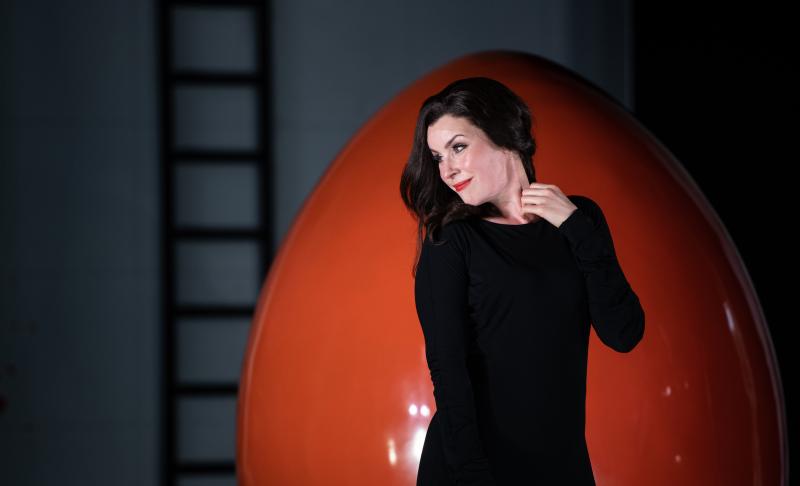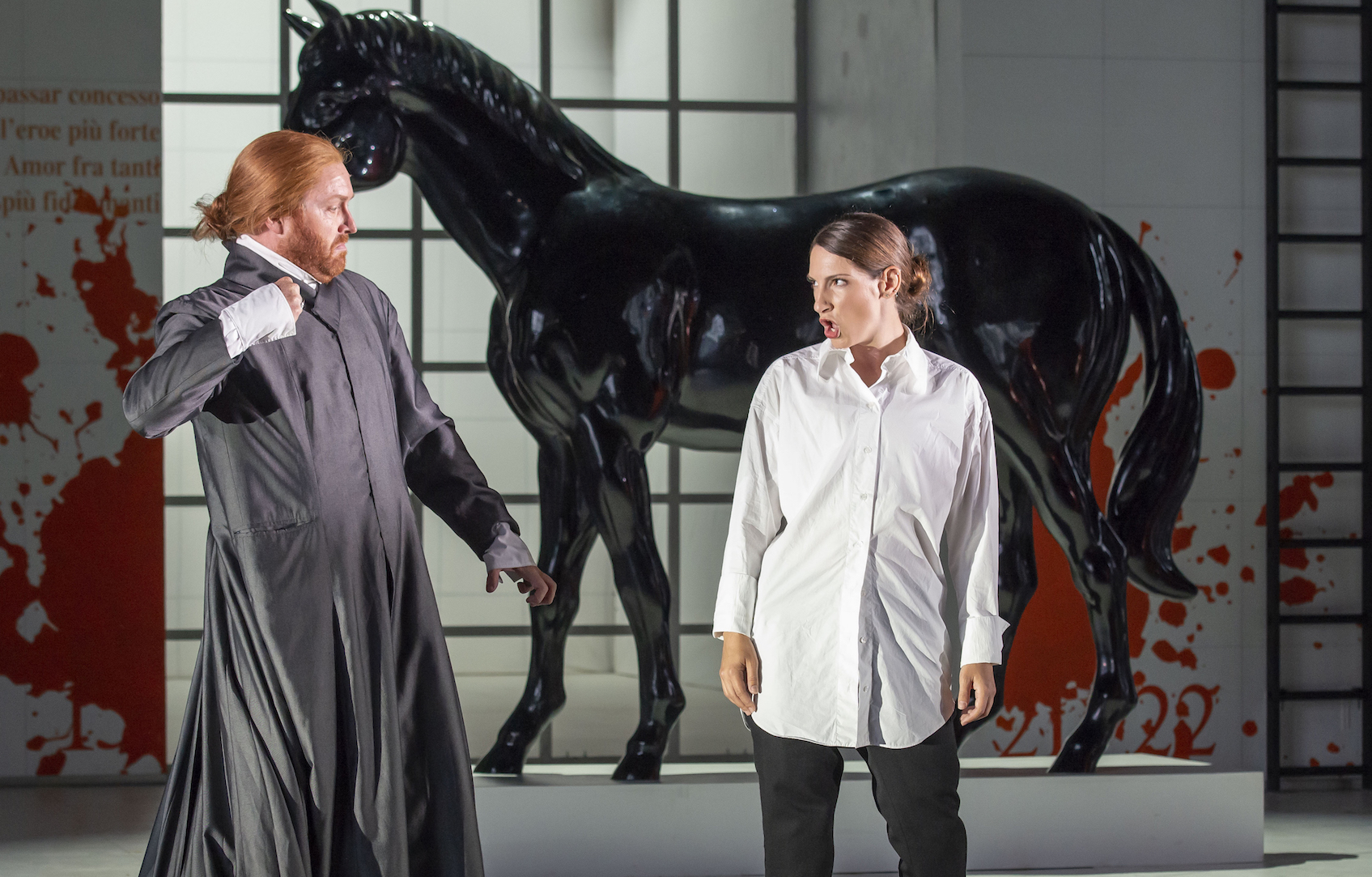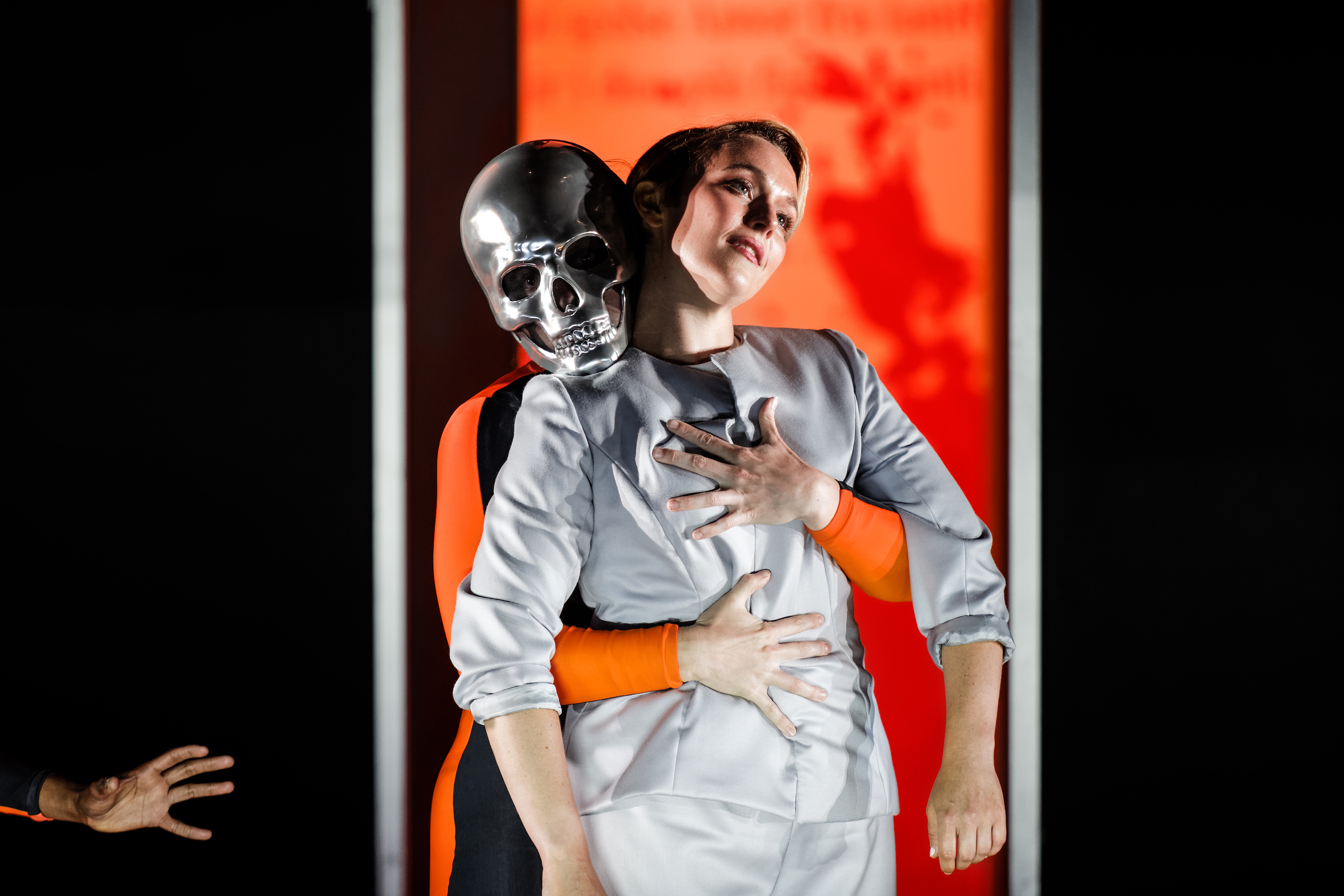Amadigi, Garsington Opera review – geometries of enchantment | reviews, news & interviews
Amadigi, Garsington Opera review – geometries of enchantment
Amadigi, Garsington Opera review – geometries of enchantment
A bold abstract setting for Handel's gloriously human score

In Handel’s operas (as, indeed, elsewhere in art and life) the worst witch may turn out to have the best character. Without the sorceress Melissa, splendidly full of evil ruses yet endowed with a generous measure of tragic pathos, Amadigi di Gaula might freeze into a static amorous stand-off between pasteboard nobles contending with a harsh – then, suddenly, kindly – fate.
Thank goodness that Irish soprano Anna Devin, as the lovelorn enchantress, graces Netia Jones's ingenious if somewhat hyper-active production of Handel’s 1715 heroic romance in Garsington Opera’s pavilion at Wormsley. In a work stuffed to bursting with marvellous (if too little-heard) music, her contributions shone especially bright, from the tender first-act largo “Ah! Spietato” – an exquisitely Handelian duet with oboe – to the last-ditch thunder and lightning of “Destero dall’empia Dite”. Melissa must pivot on a sixpence between pantomime villainy and heart-shredding solitude. Devin did.
Composed in Lord Burlington’s Piccadilly house, early in the composer’s run of London operas, Amadigi revives a hoary old chivalric tale of fairy-tale knights who compete for the affections of the fair captive princess, Oriana. Meanwhile, malicious Melissa casts her evil spells to secure the hero Amadigi for herself. With its tight quartet of strongly-written principals (Amadigi, his rival Dardano, Oriana and Melissa) the work suits a socially-distanced staging down to the ground. Its melodic parade of da capo set-piece numbers may suggest masque or pageant more than interactive drama. But Jones’s stagecraft made clever use of the pavilion’s broad acres to craft a visual language for the plot’s arc of separation, searching, enchantment, confinement and liberation. Her busy and agile troupe of dancers – Handel’s nod to his French as well as Italian stylistic heritage – climbed, writhed, skipped and marched in perpetual, even sometimes distracting, counterpoint to the main action.
 Known for her video work, Jones banished any trace of picturesque Baroque design. She presented instead an abstract monochrome grid punctuated by black-and-white towers fitted with ladders, on a stage strewn with opaque symbols – giant letters, an orange egg, a statue-like horse (pictured above by Julian Guidera). The dancers served too as Melissa’s sinister, skull-masked little helpers, both agents and victims of her remote-control machinations. After the interval, as the light of a midsummer evening faded through the Wormsley pavilion’s transparent sides, video projections enriched the stark angularity of the set. Jones added a lurid tangerine to her monochrome palette. Orange was indeed the new black. I don’t think that her visual conceptions – half-Mondrian, half-De Chirico – or Jake Wiltshire’s lighting design imposed any arbitrary gimmicks on the work. After all, rigid geometries of fate, will and compulsion direct these figures’ progress; and a director has every right to seek striking metaphors for their conditions of imprisonment and ensnarement. Yet, for all the initial austerity of the set, Jones’s optical extravagances – above all in the second half – did result in episodes of sheer sensory overload. Then, this blissful music had to struggle to tell its own, deeply human story. In the midst of such sublime arias and duets, how much of a Cubist disco do we really need to see?
Known for her video work, Jones banished any trace of picturesque Baroque design. She presented instead an abstract monochrome grid punctuated by black-and-white towers fitted with ladders, on a stage strewn with opaque symbols – giant letters, an orange egg, a statue-like horse (pictured above by Julian Guidera). The dancers served too as Melissa’s sinister, skull-masked little helpers, both agents and victims of her remote-control machinations. After the interval, as the light of a midsummer evening faded through the Wormsley pavilion’s transparent sides, video projections enriched the stark angularity of the set. Jones added a lurid tangerine to her monochrome palette. Orange was indeed the new black. I don’t think that her visual conceptions – half-Mondrian, half-De Chirico – or Jake Wiltshire’s lighting design imposed any arbitrary gimmicks on the work. After all, rigid geometries of fate, will and compulsion direct these figures’ progress; and a director has every right to seek striking metaphors for their conditions of imprisonment and ensnarement. Yet, for all the initial austerity of the set, Jones’s optical extravagances – above all in the second half – did result in episodes of sheer sensory overload. Then, this blissful music had to struggle to tell its own, deeply human story. In the midst of such sublime arias and duets, how much of a Cubist disco do we really need to see?
 That said, the singers and players more than stood their ground whenever optical illusions threatened to trump auditory realities. If Devin’s often sympathetic Melissa excelled from cackle to crow, lament to swoon, Sonja Runje’s deep, smoky mezzo in the title role (first written for the famous castrato Nicolini) added emotional amplitude to the rounded security of her tone (pictured above by John Snelling with Tim Mead). Vocally, she felt safe and strong even in Handel’s most acrobatic runs. Physically, Runje had a fair amount of gymnastic clambering and jumping to do, including a perilous leap from that statuesque steed. Even when pinned to the floor, though, she still mastered a string of glorious numbers from the early “Notte amici dei riposi” to the utterly ravishing cavatina “Sussurate, onde vezzose”. Counter-tenor Tim Mead’s Dardano could have been a stiff and formal foil for the central tug-of-love trio of Amadigi, Oriana and Melissa. But the choice quality of his arias, and the sheer class of their delivery, made him a more than equal partner. Mead mingled high-impact robustness with yearning sensitivity all the way from his opening defiance, “Pugnero contro il fato”, to the aching resignation of “Pena tiranna”, with its magical bassoon and oboe obbligato. Rhian Lois’s bewitched and caged Oriana (pictured below by Craig Fuller) takes time to come into her own – Handel’s fault, not the soprano’s. Still, when we really hear Oriana’s voice, Lois’s full, radiant tone, sensitively ornamented, touched the heights of some of the opera’s most affecting music, above all in the third act “Dolce vita del mio petto”.
That said, the singers and players more than stood their ground whenever optical illusions threatened to trump auditory realities. If Devin’s often sympathetic Melissa excelled from cackle to crow, lament to swoon, Sonja Runje’s deep, smoky mezzo in the title role (first written for the famous castrato Nicolini) added emotional amplitude to the rounded security of her tone (pictured above by John Snelling with Tim Mead). Vocally, she felt safe and strong even in Handel’s most acrobatic runs. Physically, Runje had a fair amount of gymnastic clambering and jumping to do, including a perilous leap from that statuesque steed. Even when pinned to the floor, though, she still mastered a string of glorious numbers from the early “Notte amici dei riposi” to the utterly ravishing cavatina “Sussurate, onde vezzose”. Counter-tenor Tim Mead’s Dardano could have been a stiff and formal foil for the central tug-of-love trio of Amadigi, Oriana and Melissa. But the choice quality of his arias, and the sheer class of their delivery, made him a more than equal partner. Mead mingled high-impact robustness with yearning sensitivity all the way from his opening defiance, “Pugnero contro il fato”, to the aching resignation of “Pena tiranna”, with its magical bassoon and oboe obbligato. Rhian Lois’s bewitched and caged Oriana (pictured below by Craig Fuller) takes time to come into her own – Handel’s fault, not the soprano’s. Still, when we really hear Oriana’s voice, Lois’s full, radiant tone, sensitively ornamented, touched the heights of some of the opera’s most affecting music, above all in the third act “Dolce vita del mio petto”.
 As Melissa works her dark magic on the lovers before admitting defeat (and dying for her pains), Handel’s orchestration thickens into an unusually rich range of colours. The English Concert under Christian Curnyn made every shade glow as warmly or brilliantly as it should. Stand-out work came not only from the woods but from glittering last-act trumpets that anticipate the festive sound-world of the Water Music. Mead’s slain Dardano returns as a polished and rather moving ghost, while young Edmund Visintin – as the “magical being” Organo – made his confident and charming mark as the deus ex machina who arrives to clear up Melissa’s mess of cross purposes and mistaken identities. Amadigi climaxes in the triumph of the hero’s trumpet-enhanced “Sento la gioia” – a virtuoso sign-off that drew the best from Runje and Curnyn’s band. By this time, as a merry pastoral ballet in far-from-clockwork orange closed the show, any lingering perplexity about Jones’s cryptic symbols had long since vanished. It was the easily-deciphered beauty, majesty and tenderness of top-notch Handel that made the twilit Chilterns ring.
As Melissa works her dark magic on the lovers before admitting defeat (and dying for her pains), Handel’s orchestration thickens into an unusually rich range of colours. The English Concert under Christian Curnyn made every shade glow as warmly or brilliantly as it should. Stand-out work came not only from the woods but from glittering last-act trumpets that anticipate the festive sound-world of the Water Music. Mead’s slain Dardano returns as a polished and rather moving ghost, while young Edmund Visintin – as the “magical being” Organo – made his confident and charming mark as the deus ex machina who arrives to clear up Melissa’s mess of cross purposes and mistaken identities. Amadigi climaxes in the triumph of the hero’s trumpet-enhanced “Sento la gioia” – a virtuoso sign-off that drew the best from Runje and Curnyn’s band. By this time, as a merry pastoral ballet in far-from-clockwork orange closed the show, any lingering perplexity about Jones’s cryptic symbols had long since vanished. It was the easily-deciphered beauty, majesty and tenderness of top-notch Handel that made the twilit Chilterns ring.
- Amadigi at Garsington Opera, Wormsley until 24 July
The future of Arts Journalism
You can stop theartsdesk.com closing!
We urgently need financing to survive. Our fundraising drive has thus far raised £49,000 but we need to reach £100,000 or we will be forced to close. Please contribute here: https://gofund.me/c3f6033d
And if you can forward this information to anyone who might assist, we’d be grateful.

Subscribe to theartsdesk.com
Thank you for continuing to read our work on theartsdesk.com. For unlimited access to every article in its entirety, including our archive of more than 15,000 pieces, we're asking for £5 per month or £40 per year. We feel it's a very good deal, and hope you do too.
To take a subscription now simply click here.
And if you're looking for that extra gift for a friend or family member, why not treat them to a theartsdesk.com gift subscription?
more Opera
 Káťa Kabanová, Glyndebourne review - emotional concentration in a salle modulable
Janáček superbly done through or in spite of the symbolism
Káťa Kabanová, Glyndebourne review - emotional concentration in a salle modulable
Janáček superbly done through or in spite of the symbolism
 Buxton International Festival 2025 review - a lavish offering of smaller-scale work
Allison Cook stands out in a fascinating integrated double bill of Bernstein and Poulenc
Buxton International Festival 2025 review - a lavish offering of smaller-scale work
Allison Cook stands out in a fascinating integrated double bill of Bernstein and Poulenc
 Tosca, Clonter Opera review - beauty and integrity in miniature
Happy surprises and a convincing interpretation of Puccini for today
Tosca, Clonter Opera review - beauty and integrity in miniature
Happy surprises and a convincing interpretation of Puccini for today
 Hamlet, Buxton International Festival review - how to re-imagine re-imagined Shakespeare
Music comes first in very 19th century, very Romantic, very French operatic creation
Hamlet, Buxton International Festival review - how to re-imagine re-imagined Shakespeare
Music comes first in very 19th century, very Romantic, very French operatic creation
 Falstaff, Glyndebourne review - knockabout and nostalgia in postwar Windsor
A fat knight to remember, and snappy stagecraft, overcome some tedious waits
Falstaff, Glyndebourne review - knockabout and nostalgia in postwar Windsor
A fat knight to remember, and snappy stagecraft, overcome some tedious waits
 Salome, LSO, Pappano, Barbican review - a partnership in a million
Asmik Grigorian is vocal perfection in league with a great conductor and orchestra
Salome, LSO, Pappano, Barbican review - a partnership in a million
Asmik Grigorian is vocal perfection in league with a great conductor and orchestra
 Semele, Royal Opera review - unholy smoke
Style comes and goes in a justifiably dark treatment of Handelian myth
Semele, Royal Opera review - unholy smoke
Style comes and goes in a justifiably dark treatment of Handelian myth
 Le nozze di Figaro, Glyndebourne review - perceptive humanity in period setting
Mostly glorious cast, sharp ideas, fussy conducting
Le nozze di Figaro, Glyndebourne review - perceptive humanity in period setting
Mostly glorious cast, sharp ideas, fussy conducting
 Fidelio, Garsington Opera review - a battle of sunshine and shadows
Intimacy yields to spectacle as Beethoven's light of freedom triumphs
Fidelio, Garsington Opera review - a battle of sunshine and shadows
Intimacy yields to spectacle as Beethoven's light of freedom triumphs
 Dangerous Matter, RNCM, Manchester review - opera meets science in an 18th century tale
Big doses of history and didaction are injected into 50 minutes of music theatre
Dangerous Matter, RNCM, Manchester review - opera meets science in an 18th century tale
Big doses of history and didaction are injected into 50 minutes of music theatre
 Mazeppa, Grange Park Opera review - a gripping reassessment
Unbalanced drama with a powerful core, uninhibitedly staged
Mazeppa, Grange Park Opera review - a gripping reassessment
Unbalanced drama with a powerful core, uninhibitedly staged
 Saul, Glyndebourne review - playful, visually ravishing descent into darkness
Ten years after it first opened Barrie Kosky's production still packs a hefty punch
Saul, Glyndebourne review - playful, visually ravishing descent into darkness
Ten years after it first opened Barrie Kosky's production still packs a hefty punch

Add comment